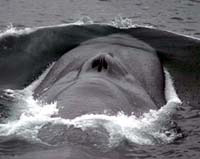Deep Sea Calendar - June
By Month - Jan | Feb | March | May | april | Aug | Sep | Oct | Nov | Dec
Gray whales (Eschrichtius robustus) migrate north through Channel Islands National Marine Sanctuary from calving grounds in Baja California, Mexico to Alaskan feeding grounds (Mid-February through May).
Humpback Whales (Megaptera novaengliae) feed in rich, upwelled waters of Channel Islands National Marine Sanctuary (May through August).
Gulf of the Farallones Sanctuary place decoys and play vocalizations to attract Common Murres to two restoration sites: Devil's Slide Rock and Point San Pedro. Northern right whales calve off the Georgia and Northern Florida Coasts. Gray's Reef Staff will be standing by to assist New England Aquarium and Georgia Department of Natural Resources teams should they need help in aerial surveys and/or strandings.Herring begins to spawn in San Francisco and Tomales Bays, Gulf of the Farallones Sanctuary

Pacific harbor seal (Phoca vitulina) pupping season on San Miguel Island (February through May).
Brant geese (Branta bernicla) stop to rest and feed in the Channel Islands region on their annual migration between Mexico and Alaska (March through May).
Endangered Least Terns (Sterna antillarum browni)Endangered Least Terns (Sterna antillarum browni) can be seen in the Channel Islands Region (May through August).
Red-Necked Phalaropes (Phalaropus lobatus) can be seen in the Santa Barbara Channel in the spring (April and May) and fall (August through October).
California sea lion (Zalophus californianus) pupping and breeding season (May through July).
Xantus's murrelets (Synthiboramphus hypoleucus) breed and nest on the Channel Islands (March through July).
Peak spawning season for Grunion (Leuresthes tenuis) on southern California beaches. Grunion leave the water at night to spawn on the beach in the spring and summer months two to six nights after the full and new moons. Spawning begins after high tide and continues for several hours (late March through early June).
Common Murres begin nesting at Tatoosh Island, the last active nest colony site on the Washington Coast, Olympic Coast Sanctuary.
Humpback and blue whales start to arrive at Cordell Bank and the Gulf of the Farallones National Marine Sanctuaries to feed on abundant krill and small schooling fish.
From June through August many species of jellies appear and drift in the nutrient rich waters in the Cordell Bank Marine Sanctuary. Black footed Albatross are most abundant in sanctuary waters. Sooty Shearwaters blanket the food rich waters of the California Coast by the millions through September as they continue on their circumnavigation of the Pacific ending up in Chile to nest.
 Deep Sea Crabs
Deep Sea Crabs